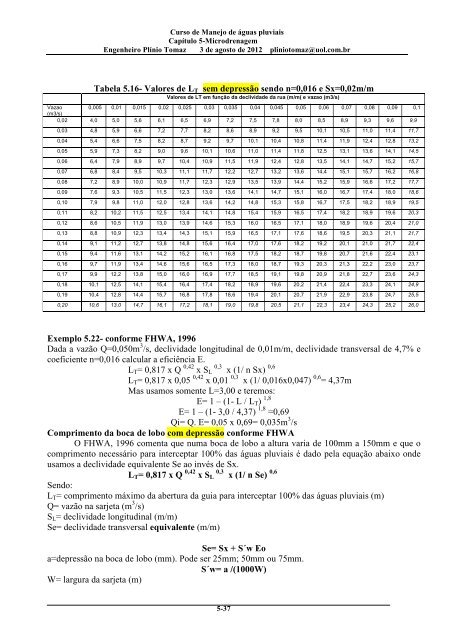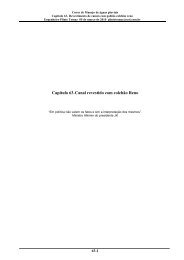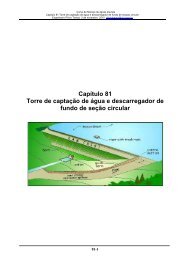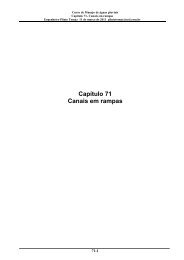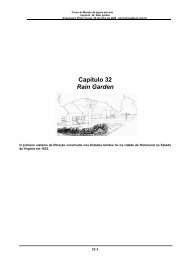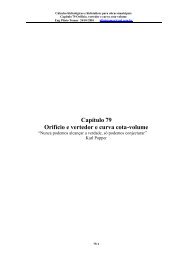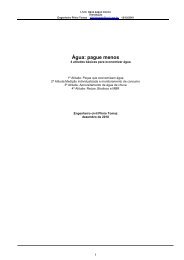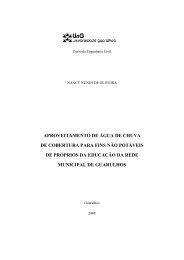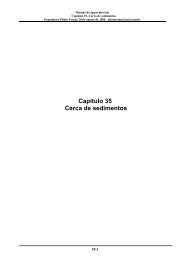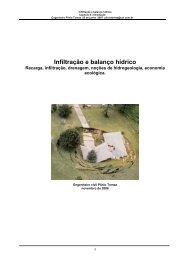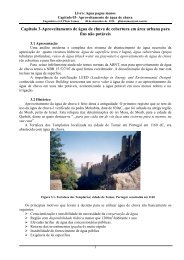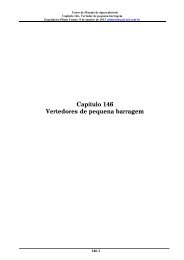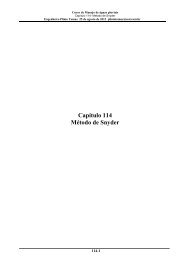CapÃtulo 5 Microdrenagem - Pliniotomaz.com.br
CapÃtulo 5 Microdrenagem - Pliniotomaz.com.br
CapÃtulo 5 Microdrenagem - Pliniotomaz.com.br
Create successful ePaper yourself
Turn your PDF publications into a flip-book with our unique Google optimized e-Paper software.
Curso de Manejo de águas pluviais<<strong>br</strong> />
Capítulo 5-<strong>Microdrenagem</strong><<strong>br</strong> />
Engenheiro Plínio Tomaz 3 de agosto de 2012 pliniotomaz@uol.<strong>com</strong>.<strong>br</strong><<strong>br</strong> />
Tabela 5.16- Valores de L T<<strong>br</strong> />
sem depressão sendo n=0,016 e Sx=0,02m/m<<strong>br</strong> />
Valores de LT em função da declividade da rua (m/m( e vazao (m3/s)<<strong>br</strong> />
Vazao 0,005 0,01 0,015 0,02 0,025 0,03 0,035 0,04 0,045 0,05 0,06 0,07 0,08 0,09 0,1<<strong>br</strong> />
(m3/s)<<strong>br</strong> />
0,02 4,0 5,0 5,6 6,1 6,5 6,9 7,2 7,5 7,8 8,0 8,5 8,9 9,3 9,6 9,9<<strong>br</strong> />
0,03 4,8 5,9 6,6 7,2 7,7 8,2 8,6 8,9 9,2 9,5 10,1 10,5 11,0 11,4 11,7<<strong>br</strong> />
0,04 5,4 6,6 7,5 8,2 8,7 9,2 9,7 10,1 10,4 10,8 11,4 11,9 12,4 12,8 13,2<<strong>br</strong> />
0,05 5,9 7,3 8,2 9,0 9,6 10,1 10,6 11,0 11,4 11,8 12,5 13,1 13,6 14,1 14,5<<strong>br</strong> />
0,06 6,4 7,9 8,9 9,7 10,4 10,9 11,5 11,9 12,4 12,8 13,5 14,1 14,7 15,2 15,7<<strong>br</strong> />
0,07 6,8 8,4 9,5 10,3 11,1 11,7 12,2 12,7 13,2 13,6 14,4 15,1 15,7 16,2 16,8<<strong>br</strong> />
0,08 7,2 8,9 10,0 10,9 11,7 12,3 12,9 13,5 13,9 14,4 15,2 15,9 16,6 17,2 17,7<<strong>br</strong> />
0,09 7,6 9,3 10,5 11,5 12,3 13,0 13,6 14,1 14,7 15,1 16,0 16,7 17,4 18,0 18,6<<strong>br</strong> />
0,10 7,9 9,8 11,0 12,0 12,8 13,6 14,2 14,8 15,3 15,8 16,7 17,5 18,2 18,9 19,5<<strong>br</strong> />
0,11 8,2 10,2 11,5 12,5 13,4 14,1 14,8 15,4 15,9 16,5 17,4 18,2 18,9 19,6 20,3<<strong>br</strong> />
0,12 8,6 10,5 11,9 13,0 13,9 14,6 15,3 16,0 16,5 17,1 18,0 18,9 19,6 20,4 21,0<<strong>br</strong> />
0,13 8,8 10,9 12,3 13,4 14,3 15,1 15,9 16,5 17,1 17,6 18,6 19,5 20,3 21,1 21,7<<strong>br</strong> />
0,14 9,1 11,2 12,7 13,8 14,8 15,6 16,4 17,0 17,6 18,2 19,2 20,1 21,0 21,7 22,4<<strong>br</strong> />
0,15 9,4 11,6 13,1 14,2 15,2 16,1 16,8 17,5 18,2 18,7 19,8 20,7 21,6 22,4 23,1<<strong>br</strong> />
0,16 9,7 11,9 13,4 14,6 15,6 16,5 17,3 18,0 18,7 19,3 20,3 21,3 22,2 23,0 23,7<<strong>br</strong> />
0,17 9,9 12,2 13,8 15,0 16,0 16,9 17,7 18,5 19,1 19,8 20,9 21,8 22,7 23,6 24,3<<strong>br</strong> />
0,18 10,1 12,5 14,1 15,4 16,4 17,4 18,2 18,9 19,6 20,2 21,4 22,4 23,3 24,1 24,9<<strong>br</strong> />
0,19 10,4 12,8 14,4 15,7 16,8 17,8 18,6 19,4 20,1 20,7 21,9 22,9 23,8 24,7 25,5<<strong>br</strong> />
0,20 10,6 13,0 14,7 16,1 17,2 18,1 19,0 19,8 20,5 21,1 22,3 23,4 24,3 25,2 26,0<<strong>br</strong> />
Exemplo 5.22- conforme FHWA, 1996<<strong>br</strong> />
Dada a vazão Q=0,050m 3 /s, declividade longitudinal de 0,01m/m, declividade transversal de 4,7% e<<strong>br</strong> />
coeficiente n=0,016 calcular a eficiência E.<<strong>br</strong> />
L T = 0,817 x Q 0,42 x S L 0,3 x (1/ n Sx) 0,6<<strong>br</strong> />
L T = 0,817 x 0,05 0,42 x 0,01 0,3 x (1/ 0,016x0,047) 0,6 = 4,37m<<strong>br</strong> />
Mas usamos somente L=3,00 e teremos:<<strong>br</strong> />
E= 1 – (1- L / L T ) 1,8<<strong>br</strong> />
E= 1 – (1- 3,0 / 4,37) 1,8 =0,69<<strong>br</strong> />
Qi= Q. E= 0,05 x 0,69= 0,035m 3 /s<<strong>br</strong> />
Comprimento da boca de lobo <strong>com</strong> depressão conforme FHWA<<strong>br</strong> />
O FHWA, 1996 <strong>com</strong>enta que numa boca de lobo a altura varia de 100mm a 150mm e que o<<strong>br</strong> />
<strong>com</strong>primento necessário para interceptar 100% das águas pluviais é dado pela equação abaixo onde<<strong>br</strong> />
usamos a declividade equivalente Se ao invés de Sx.<<strong>br</strong> />
L T = 0,817 x Q 0,42 x S L 0,3 x (1/ n Se) 0,6<<strong>br</strong> />
Sendo:<<strong>br</strong> />
L T = <strong>com</strong>primento máximo da abertura da guia para interceptar 100% das águas pluviais (m)<<strong>br</strong> />
Q= vazão na sarjeta (m 3 /s)<<strong>br</strong> />
S L = declividade longitudinal (m/m)<<strong>br</strong> />
Se= declividade transversal equivalente (m/m)<<strong>br</strong> />
Se= Sx + S´w Eo<<strong>br</strong> />
a=depressão na boca de lobo (mm). Pode ser 25mm; 50mm ou 75mm.<<strong>br</strong> />
S´w= a /(1000W)<<strong>br</strong> />
W= largura da sarjeta (m)<<strong>br</strong> />
5-37


